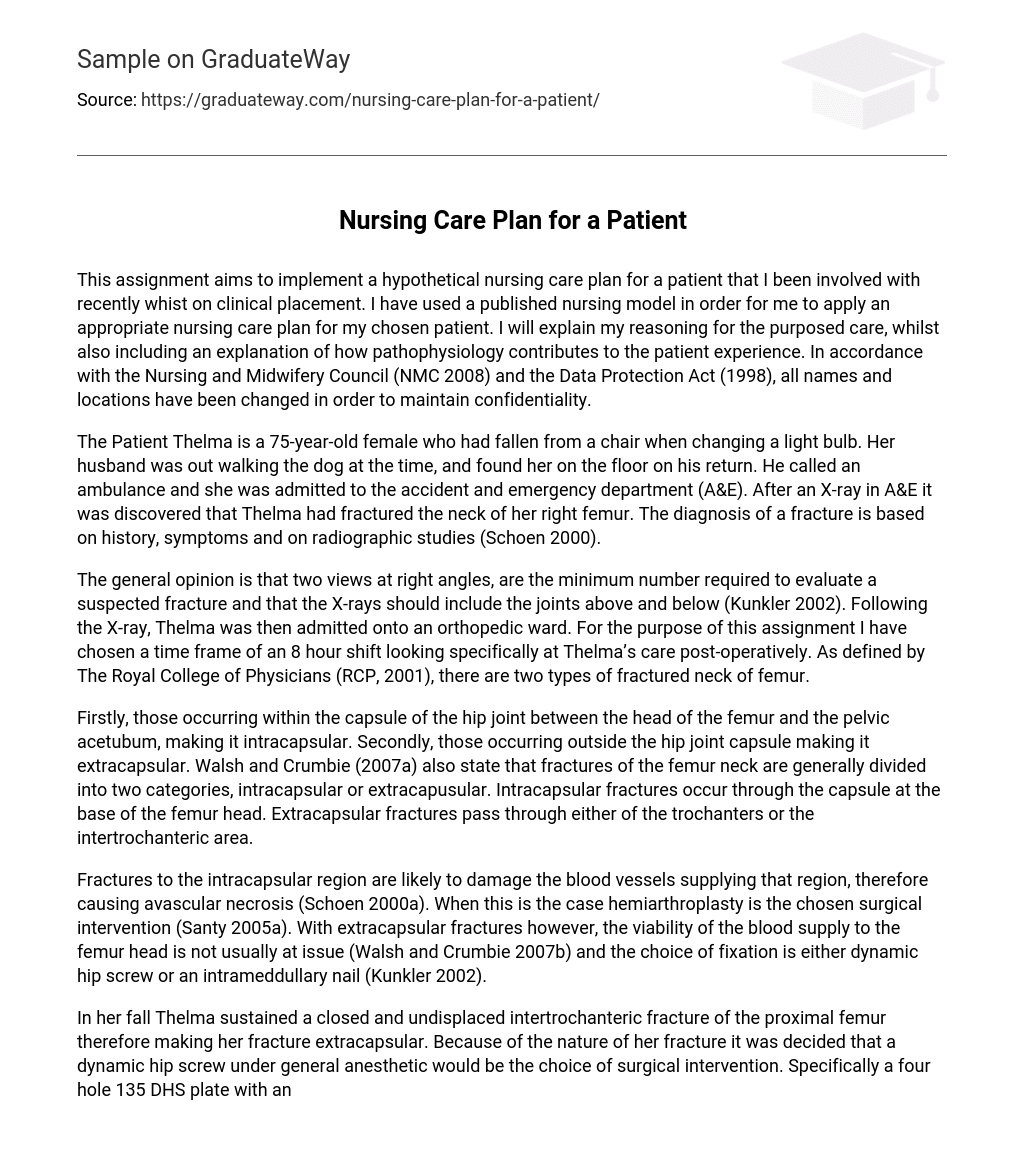In this assignment, I will be implementing a nursing care plan for a patient I encountered during my clinical placement. To develop the care plan, I utilized a published nursing model. The focus of this task is to explain the proposed care and analyze how the patient’s pathophysiology impacts their overall experience. To maintain confidentiality, all names and locations have been altered in compliance with the Nursing and Midwifery Council (NMC 2008) and the Data Protection Act (1998).
Thelma, a 75-year-old female patient, experienced a fall from a chair while changing a light bulb. Her husband discovered her on the floor after walking their dog and immediately contacted emergency services. Thelma was taken to the accident and emergency department (A&E), where an X-ray confirmed that she had fractured her right femur neck. The fracture diagnosis is determined by assessing Thelma’s medical history, symptoms, and radiographic studies (Schoen 2000).
It is widely acknowledged, according to Kunkler (2002), that a minimum of two views at right angles are necessary to assess a suspected fracture. These X-rays should include the joints above and below. After the X-ray, Thelma was admitted to an orthopedic ward. In this task, I will focus on an 8-hour shift during Thelma’s post-operative care. The Royal College of Physicians (RCP, 2001) classifies fractured necks of femur into two types.
There are two types of fractures in the hip joint: intracapsular fractures and extracapsular fractures. Intracapsular fractures occur within the capsule of the hip joint, between the head of the femur and the pelvic acetubum. On the other hand, extracapsular fractures happen outside the hip joint capsule. According to Walsh and Crumbie (2007a), femur neck fractures can be categorized as either intracapsular or extracapusular. Intracapsular fractures involve a fracture through the capsule at the base of the femur head, while extracapsular fractures pass through either of the trochanters or intertrochanteric area.
Fractures to the intracapsular region often result in damage to the blood vessels that supply this area, leading to avascular necrosis (Schoen 2000a). When this occurs, hemiarthroplasty is typically the recommended surgical procedure (Santy 2005a). In contrast, with extracapsular fractures, the blood supply to the femur head is usually unaffected (Walsh and Crumbie 2007b). In these cases, either a dynamic hip screw or an intramedullary nail is chosen for fixation (Kunkler 2002).
Thelma sustained a closed and undisplaced intertrochanteric fracture of the proximal femur during her fall. This made her fracture extracapsular. It was decided that the best surgical intervention for her type of fracture would be a dynamic hip screw under general anesthetic. Specifically, a four hole 135 DHS plate with an 85mm DHS lag screw was chosen. The wound was closed using 3/0 Monocryl and dressed with steripad. No drains were inserted. According to Harrington et al (2002) and Lorich, Geller, and Nielson (2004), a dynamic hip screw is the preferred implant for stable trochanteric fractures.
According to Koval and Zuckerman (1998), the elderly, especially those with osteoporosis, have a higher susceptibility to fractures. Osteoporosis is frequently observed in older women following a fall (Gordon 2005). It is distinguished by reduced bone mass and an increased risk of fractures (Leppert and Peipert 2003). In order to develop an effective care plan for my patient, I have decided to utilize the Roper Logan Tierney Model of Nursing, which emphasizes Activities of Living (2002).
The nursing model examines 12 daily activities performed by individuals. This model is rooted in the belief that an individual’s activities provide insight into their overall well-being, considering biological, social, and cultural factors (Aggleton and Chalmers, 2000). While some activities are necessary for survival and primarily biological in nature, others may not be essential but still contribute to enhancing quality of life. Holland et al (2008) further assert that the model encompasses various elements such as physical, psychological, socio-cultural, environmental, and politico-economic dimensions.
During my research, I examined various nursing models, such as Orem’s General theory of Nursing, Henderson’s Definition of Nursing, and Roy’s Adaptation Model. However, the Roper Logan Tierney Model stands out due to its holistic and individualistic approach. Furthermore, this model incorporates a life span continuum, which acknowledges that individuals progress from full dependence at birth to complete independence in midlife, and eventually return to full dependence in old age. Unlike other models, the Roper, Logan and Tierney Model recognizes this life span aspect and also considers the process of dying. This general-purpose nursing model can be easily adjusted and modified to suit different clinical settings. It has a patient-focused approach that encourages active participation from the patient in managing their own care. According to Bos (2008), involving patients in their care planning empowers them. This model is particularly relevant to my selected patient scenario as it acknowledges the impact of injury on the patient’s ability to perform self-care (Santy 2005b) alongside numerous severe medical complications.





